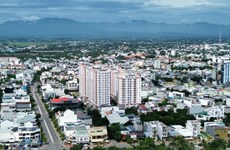Central Highlands - economic engine by 2020
The Central Highlands will become the country’s economic engine by
2020, with an average annual economic growth rate of 7.9 percent.
The Central Highlands will become the country’s economic engine by
2020, with an average annual economic growth rate of 7.9 percent.
According to the region’s master plan on socio-economic development, which was ratified by the Government on July 18, 2012, per capita income is expected to hit 24 million VND per year until 2020.
The export growth rate during the 2011-2015 period will reach 7 percent while 14,000-15,000 jobs will be generated.
Under the master plan, priorities will be given to sectors including industry, the farm and forestry product processing industry, mining and machinery.
The region has identified investment attraction as a decisive factor to fulfil the set targets.
Since 2006, regional provinces have lured 1,569 projects with registered capital amounting to 263 trillion VND.
The whole region has attracted 149 foreign direct investment projects worth over 800 million USD.
However, performance does not yet match the potential, strength and socio-economic development requirements of each locality and the whole region at large.
Poor infrastructure, especially in transport, an asynchronous and short-term master plan, unclear trade promotion strategies, complicated procedures and limited banking loans are blamed for the problem.
The Government has worked with ministries, branches and localities to devise active solutions in a bid to ease difficulties for businesses.
Accordingly, a project to upgrade National Highway No. 14 during the 2013-2015 period has been approved with construction work scheduled to begin in mid-June.
Preferential policies, especially tax and land incentives, have been offered to investors in order to give the region a competitive edge over other regions nationwide as well as the neighbouring countries of Cambodia and Laos.
The State Bank of Vietnam has also instructed commercial banks to give priorities to the region to boost its modern agriculture and competitive edge.
At the same time, the Ministry of Education and Training has supported the region in improving the quality of human resources by upgrading its universities, colleges and vocational training schools.
Regional provinces have enhanced their links while promoting investment in key economic areas and building border markets in the Vietnam-Laos-Cambodia development triangle.
Covering an area of 54,700 square kilometres, the Central Highlands encompasses Gia Lai, Kon Tum, Dak Lak, Dak Nong and Lam Dong provinces.
Apart from land and mineral resources, the region has an uninterrupted transport system connecting it with central coastal and southeastern regions.
The region is home to national and international border gates along the East-West Economic Corridor and is close to deep-water seaports such as Dung Quat, Chan May and Nhon Hoi.-VNA
According to the region’s master plan on socio-economic development, which was ratified by the Government on July 18, 2012, per capita income is expected to hit 24 million VND per year until 2020.
The export growth rate during the 2011-2015 period will reach 7 percent while 14,000-15,000 jobs will be generated.
Under the master plan, priorities will be given to sectors including industry, the farm and forestry product processing industry, mining and machinery.
The region has identified investment attraction as a decisive factor to fulfil the set targets.
Since 2006, regional provinces have lured 1,569 projects with registered capital amounting to 263 trillion VND.
The whole region has attracted 149 foreign direct investment projects worth over 800 million USD.
However, performance does not yet match the potential, strength and socio-economic development requirements of each locality and the whole region at large.
Poor infrastructure, especially in transport, an asynchronous and short-term master plan, unclear trade promotion strategies, complicated procedures and limited banking loans are blamed for the problem.
The Government has worked with ministries, branches and localities to devise active solutions in a bid to ease difficulties for businesses.
Accordingly, a project to upgrade National Highway No. 14 during the 2013-2015 period has been approved with construction work scheduled to begin in mid-June.
Preferential policies, especially tax and land incentives, have been offered to investors in order to give the region a competitive edge over other regions nationwide as well as the neighbouring countries of Cambodia and Laos.
The State Bank of Vietnam has also instructed commercial banks to give priorities to the region to boost its modern agriculture and competitive edge.
At the same time, the Ministry of Education and Training has supported the region in improving the quality of human resources by upgrading its universities, colleges and vocational training schools.
Regional provinces have enhanced their links while promoting investment in key economic areas and building border markets in the Vietnam-Laos-Cambodia development triangle.
Covering an area of 54,700 square kilometres, the Central Highlands encompasses Gia Lai, Kon Tum, Dak Lak, Dak Nong and Lam Dong provinces.
Apart from land and mineral resources, the region has an uninterrupted transport system connecting it with central coastal and southeastern regions.
The region is home to national and international border gates along the East-West Economic Corridor and is close to deep-water seaports such as Dung Quat, Chan May and Nhon Hoi.-VNA













